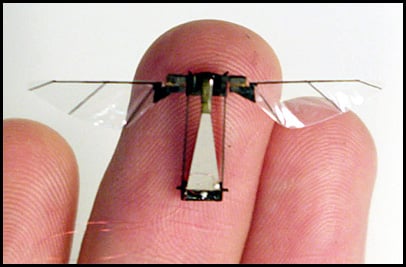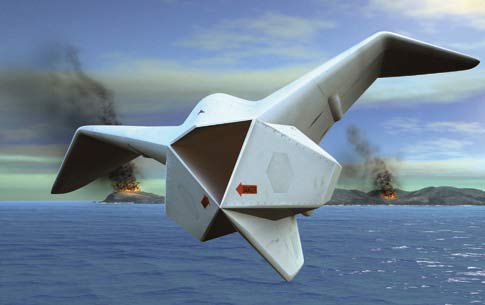 In the scifi TV series Fringe, the government gives a couple geniuses a lab and a mandate to come up with crazy technologies to defend America.
In the scifi TV series Fringe, the government gives a couple geniuses a lab and a mandate to come up with crazy technologies to defend America.
DARPA (the Defense Advanced Research Projects Agency) is kind of like that, only it has a $3.2 billion annual budget, hundreds of geniuses and it’s real.
A part of the Department of Defense, DARPA was founded in the 1950’s in response to the Soviet Union’s Sputnik program. Since then, DARPA has birthed a collection of revolutionary technologies, including the internet and stealth airplanes.
DARPA’s legal exemptions
Part of what makes DARPA so successful is that it’s exempt from laws that stifle most government agencies. Specifically, DARPA isn’t subject to Title V of the Federal Acquisition Streamlining Act of 1994, which sets up all sorts of red tape for hiring and managing personnel. DARPA also has the option of funding projects through “other transactions,” which is a special power granted by Congress to avoid the red tape normally associated with federal grants.
As a result, DARPA has a largely unrestricted $3.2 billion pot of money to use much like a venture capital firm would, doling it out to high-risk, high-reward projects, expecting a minority of them produce amazing results. Much of the money is granted to civilian firms all over the country who are free to operate their businesses as they please (as long as they produce results), which is why DARPA has been called “100 geniuses connected by a travel agent.”
Current projects
DARPA shoots for revolution, not evolution in technology. That means DARPA is working on some pretty off-the-wall stuff — the kinds of things that sound like science fiction, but aren’t. Here are 12 insane but true DARPA projects currently in the works:
1) Synthetic blood
In HBO’s True Blood series, vampires drink synthetic blood so that they don’t have bother with draining people. We’re soon going to see the real version of that, albeit not for vampires. You see, donating blood is inefficient and problematic (match types, diseases and short shelf life). These problems are especially bad for US soldiers abroad, because most blood they receive is donated in the US and has to be shipped overseas. That’s why DARPA has developed synthetic blood for battlefield applications. In the not too distant future we might think how primitive it was to have people line up to physically donate blood.
2) Sensors that can see underground
Going underground has been a way to hide from the enemy, since, well, the beginning of time. Not anymore. DARPA has developed a gravity sensor that will give pilots a real time view of underground tunnels. Combine this sensor with bunker busting bombs and underground hiding places become a thing of the past.
3) Powered exoskeletons
How much gear soldiers can carry is limited by how much they can physically lift. But what if it wasn’t? Soon soldiers could be wearing super strong exoskeletons that allow them to carry hundreds or even thousands of pounds with ease.
4) America’s manufacturing base 2.0
America’s manufacturing base has pretty much withered away and died compared to our World War II days. Aside from economic implications, this poses a threat to our national security. After all, are we going to have our weapons manufactured in China or South America? But in true DARPA fashion, the agency isn’t just trying to revive American manufacturing circa 1940. It’s investing a billion dollars to come up with new, streamlined, modular ways of manufacturing, powered by the internet and social networks.
5) Robot cyborg insects
Unmanned drones are all the rage, but unfortunately they’re big and enemies can see them. That’s why DARPA wants to turn insects into cyborg weapons. Even cooler, these cyborg insects could be mass produced using 3D printer technology. The implications of this are amazing, from a military and civilian point of view. For example, no one can find Osama Bin Laden because he’s supposedly hiding in a cave that’s hard to access. That’s no problem for an army of 1000 flying bugs! The same technology could be used in civilian rescue applications.
6) Remote controlled A-10 Warthogs
For a soldier, it’s great knowing that you can radio in an air strike. However, it’s not as easy as making a phone call. You have to go through several people, get a plane in the air, and try not to accidentally blow up yourself or your buddies. Wouldn’t it be great if a soldier could simply point and click on a map, and then a remote controlled airplane dropped bombs in exactly the right spot? It could happen. DARPA has a project in the works to use remote controlled A-10 Warthog airplanes for this purpose.
7) Mind-controlled artificial arms
Current prosthetic arms may look advanced, but without the ability control them they’re dead weight. DARPA wants to plug artificial arms into the human brain so that they can be controlled just like a natural arm. The most obvious use here is for amputees, but there are some crazy potential military applications as well, especially if this technology is combined with exoskeletons for soldiers.
8) Cars for blind people
No, this is not a joke. DARPA is looking into technology that could allow blind people to drive by combining non visual sensors (like lasers) with tactile indicators (like a glove that vibrates telling you to turn). While this is a lofty goal, the implications for this technology could drastically increase car safety in years to come, eventually moving us to a kind of car “auto pilot” that renders human drivers unnecessary.
9) A flying submarine
As any comic book super hero already knows, air planes should be able alternate between flying and going under water. DARPA is trying to make a flying submarine (or a submersible plane) a reality. Military applications for such a machine are obvious, but perhaps one day we can also look forward to a civilian flight that includes an underwater tour?
10) Programmable shape-shifting matter
In the movie Terminator 2, Arnold Schwarzenegger explains that a cyborg is made of malleable metal and can form itself into “knives and stabbing objects” (/Austrian accent). DARPA is working on the real thing with programmable shape shifting matter. In its plainest form, such material could be used to change an antenna’s shape for maximum effectiveness depending on location and circumstances. Or in the case of the military, you could make something that looks innocent, like a cupcake, that suddenly changes shape and stabs you in the face.
11) Robots that walk and balance like animals
Although robots have come a long way in the last several decades, they’re still really clumsy. DARPA has changed all that and created what can only be called the creepiest robot in the entire world. This thing looks and act like a headless dog, plus it makes a whirling sound that will give you nightmares. Just look at what happens when a man tries to kick this thing over. Like an abused, docile animal, it simply recovers its balance and continues moving — it’s probably saving up all its rage for when it becomes sentient and murderous.
12) Laser guided bullets
Humans have made amazing progress with bombs over time. We’ve gone from indiscriminate carpet bombing to laser guided, heat seeking, bunker busting “smart” bombs. Bullets, however, are still quite stupid. DARPA wants to make smart bullets that are guided in mid flight. Well it’s about time! If DARPA has its way, that little red laser dot won’t just be a cheesy fixture in 80’s and 90’s movies. It’ll actually guide bullets through wind, rain and humidity to always hit their target.
What will the future hold?
Two of the greatest things about DARPA are that it only goes after projects that seem a little far fetched, and it uses crowd sourcing to find tomorrow’s Einsteins whether they’re in a dingy garage or a state of the art lab. With a ton of money, boundless imagination and an outsourced army of geniuses, who knows what tomorrow will hold.
Thanks, DARPA, for doing your part to make the future look like the movies and thinking of crazy ways to kill people that also turn into useful civilian technologies!
















23 comments
Not a Killer
It rages me to see all our efforts in technology wasted on war rather than peace, oh well, guess people like me are the crazy ones
Lee
US and world you are Obama Darpa Invisibly Microed for Military Defense Alien Attacks and civilian surveillance! For What? Your protection? Agents said more than 1 million friendly, good natured extraterrestrials were microwave terminated by US World Darpa Military Defense because they are against detrimental DicShip.
US World Darpa Adv. Alien Tech. microing your right eye retina forms an invisible cam and an illegal ATT cell phone connection that can view you at any angle, record, harass or wifi torture you. ATT cell wifi talk to you like a cell phone in your ear live 24 hrs. a day or silent.
Do Surviving Veterans, Families, US Citizens Christians know Obama Covert Darpa Agents Are Micro Selling USA Citizens and paid 2 million a year? Obama Howard Raymond said you are paying me 1 million to stop posting Darpa micro eye implanting and microwave torturing the USA. Tell the vets that died for our freedom and all US Citizens that are losing their Invasion Of Privacy Right and freedom and getting demonic micro mind possession. Darpa is microing the world for defense alien wars with illegal cell and computer server connections.
I want you and your Covert Darpa Micro Agents publicly announced, tortured, jailed and deported back to hell.
Obama you have a lot of guts micro implanting me and my family paying millionaire - billionaire Dem. Darpa celebrities 2 million a year to micro sell out the deceased and living Vets and the surviving children and wives that lost their fathers and husbands and all Christians that died for their freedom of religion and God.
Do you believe in a Jesus Christ? Microwave Hell?
zac
Lee . Need to talk about how to stop them. Your emails read strange, hard to understand, yet your exactly correct. I am a Christian man. Lee your the only other person i know who knows this much.
Johna132
whoah this blog is wonderful i like reading your articles. fcaeecgadcek
build iron man suit
a genuine iron man suit is easy to encourage with this particular guide
Paul
Wah wah war mongers and so on. Sorry but these are technologies that will further improve our lives. DARPA is absolutely one of the most USEFUL agencies in our government. Great article.
deochan
man i' serious this is too cool
televisione milano
Magnificent goods from you, man. I've bear in mind your stuff previous to and you are simply too fantastic. I really like what you have obtained here, really like what you are saying and the way during which you are saying it. You're making it enjoyable and you still care for to stay it wise. I can't wait to learn far more from you. This is really a great website.
New Angry Birds Gifts and Toys for the New Year! Electronics, Toys, Clothes, and more
of course like your web site but you need to check the spelling on quite a few of your posts. A number of them are rife with spelling problems and I to find it very bothersome to inform the reality on the other hand I?ll certainly come back again.
bizzibiz
I like this website so much, saved to bookmarks .
Sabine
Terrific guide it should occur in helpful
Tim Giangiobbe
Dracula will be pleased with number one.
The Bunker View tunnel vision is cool maybe it can be used on Omar in Libya when he goes into hiding.
He has a reservation next to Osama Bin Laden.
There is plenty of room at the bottom of the ocean club.
How about a camera that sees the ocean bottom clearly.
Smile Osama and Omar your on Maniacal Terrorist and Despot Leader TV
Rage
Darpa is amazing
Vintage Lead
Great article, DARPA is making fiction a material reality and ensures USA's technological superiority but as Vim says above, more innovations about ozone layer or non-carbon fuels would be a better for all human race.
Studio K&M
Great article. We just recently shared a blog post regarding technology and usability and used your image of the prosthetic arm. We've included all of the info to link back to your site, but please let us know if you'd like it removed and we'll be happy to do so. Thanks for the good read!
Winston
Were is my ( JET-PACK)
Gamma Ray burst
May Be we should stop using the Internet it was invented by this scrupelous agency....
There will also some raw material be
Left to Be grabbed by the Chinese, after you have destroyed your Trade Balance.
vlm
The problem with super-advanced technology in today's societies is that they are controlled by rapacious war-mongers and greedy industrialists who want only to (1) control the world and (2) to create profits over the sanctity of human life. That is why we are in the throes of the destruction of the ozone layer (remember that?), global warming, massive oil spills and other man-made disasters.
Technology should be for the advancement of the human race, not its destruction.
Geo
Thou art demented!
MAckrel
To ...,
... And you're naive; Do we really want a government venture capital firm developing tech the market wouldn't bear that has the effect of smoothing police-state inefficiencies? S*its terrifying...
Ben
Love's got a point though. We spend WAY to much money on defense.
See here:
http://www.globalissues.org/article/75/world-military-spending
Love
The american government, a terrorist organization, with their terrorist agencys: FBI, CIA, NSA, DARPA.
Yes, I'm an american.
Andre Williams
I suppose they would seem like a terrorist organization to you. Not my fault you're scared of what you don't comprehend. Do spiders, snakes and the dark scare you too? Those damn spiders; they're terrorists I tell you!